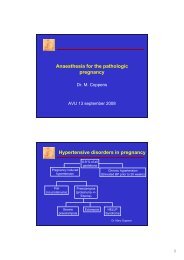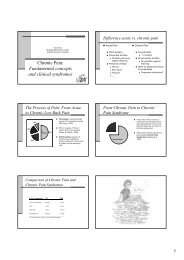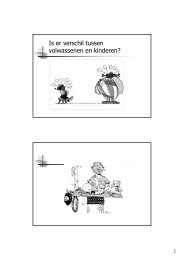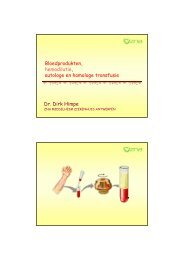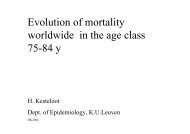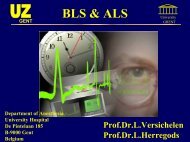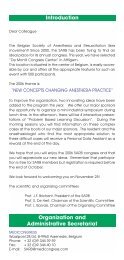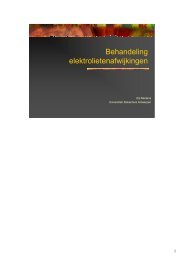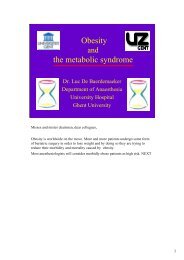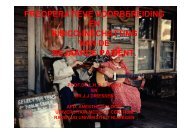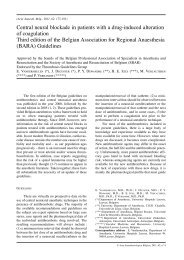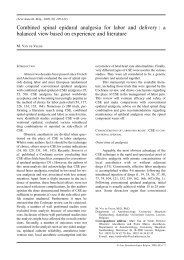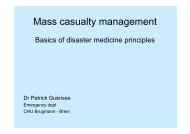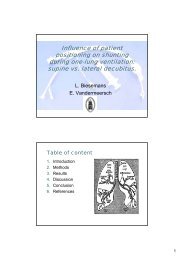Postoperatieve complicaties, exclusief respiratoire
Postoperatieve complicaties, exclusief respiratoire
Postoperatieve complicaties, exclusief respiratoire
Create successful ePaper yourself
Turn your PDF publications into a flip-book with our unique Google optimized e-Paper software.
PACU en Post-Anesthesie<br />
Verwikkelingen<br />
Dr. Caroline Vanlersberghe<br />
Dienst Anesthesiologie<br />
Academisch Ziekenhuis<br />
Vrije Universiteit Brussel<br />
Ontwaken uit Anesthesie<br />
Luchtwegobstructie<br />
Rillen<br />
Nausea en braken<br />
Agitatie, delirium<br />
Pijn<br />
Hypothermie<br />
Labiliteit autonoom zenuwstelsel<br />
De Low-Care Afdeling<br />
Factoren die Impact hadden op<br />
PostAnesthesie Zorgen<br />
Creatie van specifieke zone voor observatie en<br />
behandeling van patient na anesthesie/heelkunde<br />
Ontwikkeling gespecialiseerde nursing voor<br />
onderkennen van specifieke <strong>complicaties</strong> tijdens de<br />
onmiddellijke postoperatieve periode<br />
Identificatie en beschikbaarheid van anesthesioloog<br />
voor medisch beleid PACU<br />
Standaardnormen en -procedures voor PACU<br />
Speciale zorgeenheden voor specifieke populaties<br />
(low/high/pediatric care/extended observation unit)<br />
Taak van de PACU<br />
Medische supervisie en coördinatie patiëntenzorg<br />
Observatie en bewaking van vitale functies en<br />
psychische toestand van de geopereerde patiënt<br />
Specifieke bewakingstechnieken (hart- en<br />
longfuncties)<br />
Bijstand en sturing van oxygenatie, ventilatie,<br />
circulatie en lichaamstemperatuur<br />
Diagnose en accurate behandeling van<br />
postoperatieve <strong>complicaties</strong><br />
Probleemstelling PACU<br />
Hoge doorstroming van patiënten in beperkte<br />
ruimte<br />
Mix van patiënten met verschillende<br />
conditionerings- en stabilisatieproblemen<br />
Verwikkelingen anecdotisch gerapporteerd<br />
• Hemodynamische incidenten : meest frequent<br />
• Respiratoire <strong>complicaties</strong> : meest significante morbiditeit<br />
1
PACU Situaties met Morbiditeit<br />
Respiratoir<br />
• hypoventilatie, luchtwegobstructie<br />
Hemodynamisch<br />
• aritmie, bloeddrukwijzigingen, ischemie<br />
Nausea en braken<br />
Hypothermie<br />
Ontwaakdelirium<br />
Respiratoire Bewaking<br />
Luchtweg obstructie :<br />
• farmaca : sedatie, spierhypotonie, areflexie<br />
• weerslag : hypoventilatie, mucusevacuatie, bronchospasme,<br />
atelectase, aspiratie, acuut longoedeem<br />
Residuele curarisatie / anesthetica :<br />
• laryngeale incompetentie, V/Q stoornissen<br />
Type heelkunde: hoofd, hals, thorax, abdomen,<br />
wervelzuil (atelectasen)<br />
Pijn : narcotica, CZS depressie<br />
Pulsoximetrie<br />
Impaired Ventilatory Response to<br />
CO 2<br />
Transport naar PACU<br />
• 35% patienten S p O 2 < 90% (P a O 2 60 mmHg)<br />
Ventilatio<br />
• 12% patienten S p O 2 < 85% (P a O 2 50 mmHg)<br />
n,<br />
• Kinderen : cyanose aanwezig in < 50% met desaturatie<br />
L/min<br />
• O 2 toediening tijdens transport<br />
Continue bewaking S p O 2<br />
Ontslag uit PACU : geen relatie PAR scores<br />
en oxygenatie<br />
• voor ontslag : S p O 2 92-96% met lucht 10-15 min<br />
Pa CO 2 , mm Hg<br />
Inhalation Anesthetics and<br />
Ventilatory Response to Hypoxia<br />
Ventilation,<br />
L/min<br />
Anesthesia<br />
levels as low as<br />
0.1 MAC<br />
Implication:<br />
Inability of<br />
anesthetized<br />
patient to<br />
increase low<br />
arterial PO 2<br />
through<br />
hyperventilation<br />
V E<br />
V T<br />
RR<br />
Hypoxia and Sevoflurane<br />
Anesthesia<br />
End-tidal sevoflurane 0.8 MAC<br />
• V T decreased by 51 %<br />
• RR increased by 74 %<br />
• Acute hypoxic ventilatory response<br />
reduced by 60 %<br />
End tidal PO 2 ,<br />
mm Hg<br />
Sjögren et al., Anesth Analg 1999<br />
2
The Mean Ventilatory Responses to<br />
Sustained Hypoxic Test during Propofol<br />
Infusion<br />
Hypoxic Ventilatory Response and<br />
Neuromuscular Blocking Agents<br />
The relationship between glomus cell<br />
chemoreceptor activity and P a O 2<br />
following 0.1 or 0.5 mg i.v. vecuronium<br />
(rabbit)<br />
Hypoxic ventilatory responses<br />
before and during infusion of<br />
muscle relaxants at TOF 70 %<br />
and 90 %.<br />
Eriksson, Anesth Analg 1999<br />
Hemodynamische Functie<br />
Cardiovasculaire Problemen<br />
Training : BD, CVD, POD, PAD<br />
Risicofactoren :<br />
• hypertensie, cardiovasculaire pathologie<br />
• ASA, ouderdom, heelkunde<br />
• dringendheid heelkunde<br />
Nut van grenswaarden?<br />
Hypotensie<br />
• hypovolemie<br />
• hypoxie<br />
• afname autonome<br />
tonus<br />
• overdosering<br />
medicatie<br />
• low output failure<br />
Hypertensie<br />
• pijn<br />
• hypoxie, hypercarbie<br />
• blaasdistentie<br />
• perifere<br />
vasoconstrictie<br />
• intracraniele<br />
heelkunde<br />
• majeure vasculaire<br />
heelkunde<br />
Therapie: O 2 + behandel oorzaak<br />
Postoperative Hypertension: Factoren die<br />
<strong>Postoperatieve</strong> SZS activiteit verhogen<br />
↑ Sympatische activiteit<br />
• Schadelijke stimuli:<br />
• Pijn, angst, craniële stimulatie, volle blaas, ET<br />
• Nadelige fysiologische condities:<br />
• Hypercarbia/acidosis, hypoxemia, hypotensie,hypolycemie,<br />
congestief hartfalen, ↑ intracraniële druk,myocard ischemie<br />
• Medicatie:<br />
• β-mimetische pressoren, ephedrine, isoproterenol, epinephrine<br />
• Dopamine, dobutamine<br />
• Brochodilators, terbutaline,aminophylline<br />
• Antihypertensiva, hydralazine, nitroprusside<br />
• Anesthetics:<br />
• Ketamine, isoflurane<br />
Cardiovasculaire Problemen<br />
Tachycardie<br />
• pijn<br />
• orthosymp. stimulatie<br />
• hypovolemie<br />
• hypotensie<br />
• hypoxemie<br />
• koorts<br />
• endotoxine shock<br />
Bradycardie<br />
• spinale / epidurale<br />
• hypothermie<br />
• toename ICP<br />
• atleet<br />
• residueel effect van<br />
neostigmine, β-blokker<br />
↓ Parasympatische activiteit<br />
• Medicaties:<br />
• Parasympatholytica: atropine, glycopyrrolaat<br />
• Spierrelaxantia: pancuronium<br />
3
Bradycardie<br />
↑ Parasympatische activiteit<br />
• Vagale reflexen:<br />
• Carotis sinus massage, valsalva maneuver, kokhalzen, rectaal<br />
onderzoek, ↑ oculaire druk, blaas distentie, faryngeale stimulatie<br />
• Parasympathomimetische medicatie:<br />
• Acetylcholinesterase inhibitor: neostigmine, edrophonium<br />
• Alfa-adrenerge farmaca: neosynephrine, norepinephrine<br />
• Opioiden: morphine, fentanyl, sufentanil, alfentanil, remifentanil<br />
• Succinylcholine<br />
↓ Sympatische activiteit<br />
• Hoge spinale of epidurale anesthesie<br />
• Wegnemen van stimulus, extubatie, blaaslediging<br />
• Zware acidemie/hypoxemie<br />
• Sympatholytische medicatie:<br />
• Beta-receptor blokkers (propranolol)<br />
• Opioiden/sedativa/algehele anesthesie<br />
• Ganglion blokkers<br />
• Lokale anesthetica<br />
Myocard Ischemie<br />
Risicofactoren<br />
• Gekende coronaire pathologie, congestief<br />
hartfalen, perifeer vaatlijden<br />
• Ouderdom<br />
• Beperkte inspanningstolerantie<br />
• Chronische nierinsufficiëntie<br />
• Ongecontroleerde hypertensie<br />
• Linker ventrikel hypertrofie<br />
• Gebruik van digoxine<br />
Dynamische predictoren<br />
Tachycardie<br />
Hypotensie Hypertensie<br />
Hypoxemie<br />
(ventilatie,<br />
anemie, 2,3 DPG)<br />
Silent<br />
myocardial<br />
ischemia<br />
Autonome<br />
dysfunctie<br />
(stress, pijn, shivering<br />
ontwaak delirium)<br />
Hypercoagulabiliteit Coronair spasme<br />
Afname fibrinolyse<br />
4



